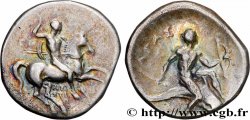bgr_988619 - CALABRIA - TARAS Drachme
5 000.00 €约 41900.00 CNY
数量
加入购物车

种类 Drachme
日期: c. 280-272 AC.
铸币厂名称/城市 Tarente, Calabre
材质 gold
直径 14,5 mm
模子方针 1 h.
重量 4,28 g.
稀少度 R3
关于品相的说明
Bel exemplaire, centré des deux côtés. Joli portrait d’Héraklès ainsi qu’un revers agréable. Patine de collection
出版目录中的项代码 :
家谱
Avec son certificat d'exportation de bien culturel n°251224 délivré par le ministère français de la Culture
正面
正面的文字 ANÉPIGRAPHE.
正面的说明书 Tête imberbe d’Héraklès à droite, coiffé de la léonté.
背面
背面的说明书 Taras nu dans un bige galopant à droite, tenant les rênes de la main droite et un trident de la main gauche.
背面铭文 (AR)/ (NK)/ SWSI/ [TARANTINWN]
背面的翻译 (des Tarentins).








 对产品描述纠错
对产品描述纠错 打印
打印 分享我的选择
分享我的选择 提问
提问 Consign / sell
Consign / sell
 产品介绍
产品介绍






